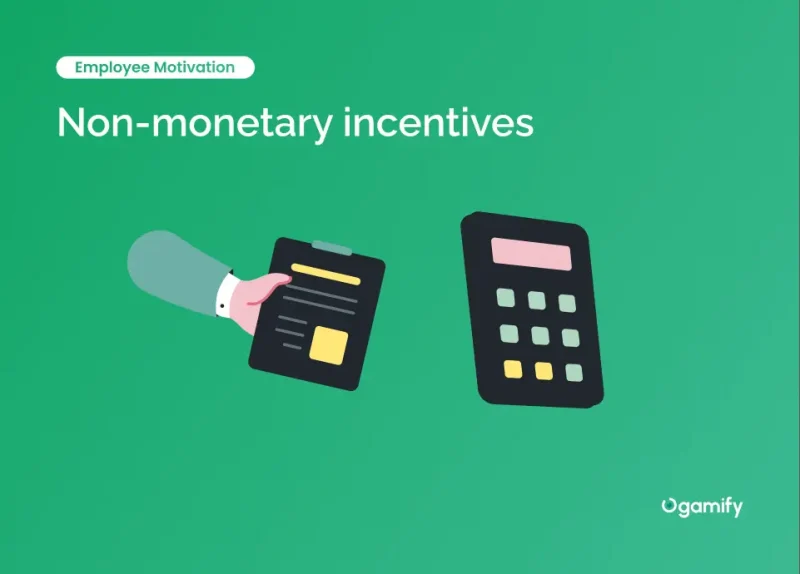In today’s dynamic work environment, companies increasingly recognize the significance of non-monetary incentives in motivating employees. While financial compensation remains essential, non financial motivation has emerged as a powerful tool to engage and retain talented individuals.
By understanding the various types of non monetary motivation and exploring the benefits they offer, organizations can create a bunch of examples of non-monetary benefits fulfilling work environments for their employees. This article explores the importance of non-monetary incentives, their different forms, and their advantages to employees and employers.
What are non monetary incentives?

Non monetary rewards refer to prizes or benefits offered to individuals that do not involve financial compensation. These incentives are designed to motivate and engage individuals by appealing to their non-financial needs and desires. While you reward employees with monetary incentives, it can certainly be effective, but benefits of non financial motivation recognize that other factors can drive employee or individual satisfaction and productivity.
Examples of non financial considerations includes flexible work hours, recognition and appreciation, opportunities for personal and professional development, a positive work environment, and meaningful work assignments. These incentives tap into intrinsic motivators such as a sense of purpose, autonomy, and personal growth.
Why is non-financial motivation important?

Honest compensation is the foundation for retaining talent in your workplace, but what else can you do to foster good relationships with your employees? The answer lies in non-monetary rewards, which have the added advantage of helping you build strong connections with your staff. While salary can always be outbid by competitors, a strong company culture that recognizes efforts will pay off with higher employee retention.
It’s essential to go beyond financial incentives and consider the value of non monetary motivators in creating a supportive and fulfilling work environment. These initiatives go a long way in demonstrating your commitment to your employees’ well-being and growth.
By implementing non-monetary rewards and benefits, you boost employee morale and motivation and foster a sense of loyalty and commitment. Employees who feel appreciated and valued beyond their paycheck are likelier to stay with the company and contribute their best efforts. Moreover, non financial employee benefits can help strengthen relationships between managers and employees, fostering open communication, trust, and collaboration.
Investing in a culture that prioritizes non financial rewards and motivators can yield numerous benefits for your organization. It can enhance productivity, promote teamwork, attract top talent, and create a positive reputation as an employer of choice. Moreover, it contributes to a more harmonious and supportive work environment where employees feel engaged, satisfied, and motivated to excel.
What are the types of non-financial motivation?
Flexible working

Flexible working refers to a work arrangement that allows employees more control over their working hours, location, or schedule. It will enable individuals to adjust their work hours to suit their personal needs and responsibilities outside of work. This can include remote work, flextime, compressed workweeks, job sharing, or part-time schedules.
By offering flexible working options employers demonstrate trust and respect for employees and recognizing their diverse needs and circumstances. This acknowledgement fosters a sense of autonomy, empowerment, and loyalty among employees, increasing job satisfaction and morale.
Job Enlargement
Job enlargement involves providing employees with more challenging and meaningful work tasks that contribute to their sense of achievement and growth. By expanding the job scope through job enlargement, employees can experience increased job cont and a sense of accomplishment, which can act as intrinsic motivators.
Furthermore, job enlargement can improve employee engagement and motivation by promoting a sense of autonomy and empowerment. When employees are given more varied tasks and responsibilities, they have greater control and decision-making authority over their work. Another motivation factor could be autonomy, as they feel a sense of ownership and responsibility for their job outcomes.
Job Enrichment
Organizations can offer non financial rewards to motivate employees, such as personal growth and development opportunities, by enriching job roles. Workers can feel a sense of progress and achievement by being allowed to learn new skills, take on more challenging tasks, and acquire additional responsibilities. This personal and professional development motivates individuals to improve their abilities and advance in their roles.
It provides non financial benefits for employees by enhancing job contentment and engagement. When employees can work on intellectually stimulating tasks that align with their skills and interests, they are more likely to feel fulfilled and enjoy their work.
Individual meeting

An individual meeting, a one-on-one meeting or a personal check-in refers to a dedicated session between a supervisor or manager and a particular employee. It provides an opportunity for open and private communication, feedback exchange, goal setting, and addressing any concerns or challenges.
Individual meetings offer non cash incentives for employees by demonstrating care, support, and recognition of their needs and contributions. When employees are given a chance to have personalized discussions with their supervisors, it shows that their opinions and perspectives are valued, and their well-being is considered important.
Appreciation
Appreciation in the workplace refers to recognizing and acknowledging employees’ efforts, contributions, and achievements. It involves expressing gratitude and giving positive feedback to individuals or teams for their work performance, behaviours, or accomplishments.
When employees feel appreciated and valued for their efforts, it boosts their morale, job fulfilment, and overall motivation. This sense of recognition can foster a positive psychological climate where employees are more engaged, committed, and willing to go the extra mile.
Non financial rewards examples associated with appreciation in the workplace can include public recognition during company meetings or on chat, verbal or written praise; other employees could also create this to support each other or give feedback about the progress someone’s made. You could also try a gamification system to make the feedback process become an enjoyable habit.
Growth Opportunity
Workplace development opportunities refer to initiatives or programs that provide employees with opportunities to enhance their skills, knowledge, and abilities. These opportunities can include training programs, workshops, mentoring relationships, job rotation, or special projects that allow employees to learn and grow professionally.
Organizations create a culture that values continuous learning and growth by offering development opportunities. Employees are more likely to be motivated when they perceive that their organization invests in personal and professional development.
Team- building activities
Team-building activities refer to planned exercises, games, or events that promote team members‘ collaboration, communication, and cohesion. These activities aim to strengthen relationships, foster a sense of belonging, and enhance teamwork within the workplace culture.
Team-building activities can foster a positive work environment and enhance employee motivation by promoting a sense of camaraderie. Team members can develop stronger relationships, build trust, and improve communication by engaging in interactive and fun activities. This sense of belonging and connection can boost morale and workplace motivation, increasing job satisfaction and productivity.
What are the benefits of non-monetary incentives?

Increased employee motivation and productivity
Non financial incentives are crucial to motivating employees, as they tap into intrinsic motivators such as personal growth, autonomy, and a sense of purpose. These motivation factors go beyond monetary rewards and can foster a deeper connection between employees and their work.
As a result, employees who feel motivated on a deeper level are more likely to be engaged in their work, take initiative, and strive for excellence. It is important to remember that these motivation factors contribute to increased productivity and better overall performance, making them key elements in any successful business strategy.
Reduced turnover and increased retention
Offering non-financial incentives can significantly impact employee retention. When employees feel valued and rewarded beyond financial compensation, they develop a sense of loyalty and commitment to the organization.
They are less likely to seek opportunities elsewhere and more likely to stay and contribute their skills and knowledge to the company’s success.
Cost-effectiveness compared to monetary incentives

While financial motivational strategy can be expensive, non monetary benefits can often be implemented at a lower cost. For example, providing flexible work hours or opportunities for professional development may require minimal financial investment but can substantially impact employee satisfaction and increase motivation.
This cost-effectiveness makes non financial motivators attractive for organizations, especially those with limited budgets.
Enhanced employee well-being and work-life balance
Methods of non financially rewarding employees, such as offering a positive work environment, promoting work-life balance, and providing employee benefits beyond salary, contribute to the overall well-being of employees.
When employees feel supported and valued holistically, they experience greater job fulfillment and are less likely to experience burnout or stress-related issues. This, in turn, improves their overall quality of life and their ability to perform effectively at work.
Improved relationships and collaboration
Companies that use non-monetary incentives can help strengthen relationships between managers and employees. Recognition programs, team-building activities, and a supportive work environment foster open communication, trust, and collaboration.
Employees who feel valued and appreciated are likelier to engage in constructive dialogue, share ideas, and work together towards common goals. This synergy enhances teamwork and creates a positive and cohesive work culture.
The attraction of top talent
Companies that offer appealing non cash incentives have a competitive advantage when it comes to attracting top talent. In today’s job market, candidates often consider factors beyond salary when choosing an employer.
A company that prioritizes non financial rewards and benefits sends a strong message that it values its employees and invests in their growth and well-being. This can make the organization more desirable to prospective employees and position it as an employer.
Conclusion

In conclusion, non-monetary compensation examples are valuable tools for motivating and engaging employees. They offer non financial benefits, rewards, and motivators beyond traditional compensation.
By recognizing the importance of non financial factors and incorporating them into their strategies, companies can create a supportive work environment that attracts top talent, fosters collaboration, and enhances employee well
FAQ
Do non-monetary incentives work as effectively as monetary incentives?
Yes, non-monetary incentives can be just as effective as monetary incentives in motivating employees. While financial rewards are important, non-monetary incentives address employees’ emotional needs, promote a positive work culture, and contribute to long-term motivation and engagement.
How can organizations determine which non-monetary incentives are most effective for their employees?
Organizations can determine the most effective non-monetary incentives by conducting employee surveys, seeking feedback, and engaging in open dialogue. Understanding employees’ preferences and needs can help tailor non-monetary incentives to their specific motivations and enhance their impact.
Can non-monetary incentives be combined with monetary rewards?
Absolutely. Non-monetary incentives can complement monetary rewards to create a comprehensive rewards and recognition program. By combining both types of incentives, organizations can cater to different employee preferences and provide a well-rounded motivational approach.
What if some employees do not value non-monetary incentives?
It is important to recognize that individuals have diverse preferences and motivations. While non-monetary incentives may not resonate with everyone, they can still contribute to a positive work environment. Organizations should strive to provide a mix of incentives to accommodate different needs and preferences.


